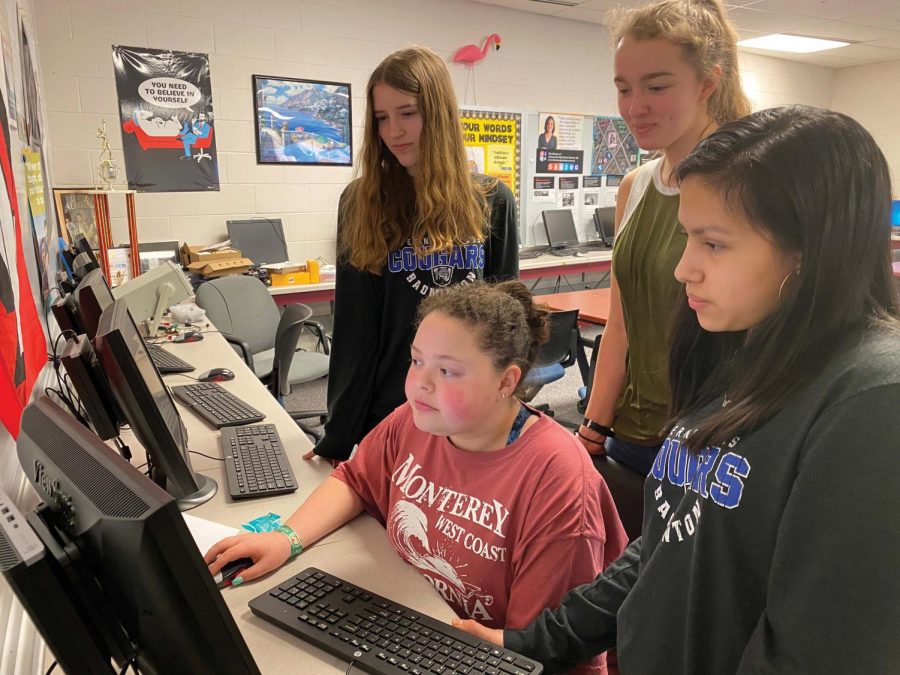Girls code for the future
Several members of the club work hard on fixing a code.
So little do we hear young boys tell their parents they want to be teachers or nurses when they grow up, and it is equally uncommon to hear young girls say they want to pursue engineering — a predominantly male field. Girls Who Code is a club that empowers its female members to excel in the STEM field.
According to the U.S. Bureau of Labor Statistics, women make up only 15.7% of the engineering occupations population. To combat this meager number, Girls Who Code strives to promote female participation through a variety of events and competitions.
Adam Lueken, the club’s advisor, described the club as an “organization that is trying to fight an epidemic where there are so few women in technology.”
With such little diversity in the tech realm, the process of creating and developing does not truly reflect the demographics of the consumers.
“Whether it’s gender or race, when you don’t have diversity on various teams, what you create doesn’t really represent the world,” Lueken said. Computer science is not exclusively math. It involves investigative and critical thinking skills which are meant to benefit students in the future.
Zosia Okinczyc (11) has been a part of Girls Who Code for two years, and plans on pursuing a career in mechanical engineering.
“It’s a lot of problem solving. Sometimes you have to think outside the box, or try to find a more efficient way to do something. That’s really more critical thinking and less math,” Okincyzc stated.
Often times, people overlook the creative freedom of computer science. Programming allows for flexibility in design and function, and Girls Who Code sparks this curiosity and creativity.
“A lot of people think of computer science as coding and maybe not the most creative field, but it can actually be designing apps and creating different projects. It can be a creative pursuit,” said Okinczyc.
To empower its female members, Girls Who Code is mainly led by the girls with Lueken simply acting as a helping hand rather than having a dominant role. The events, the creating and the advertising are all aspects that the members have control over.
Both Okinczyc and Shayna Weinstein (10) enjoy computer science and Girls Who Code because of its relaxing environment and supportive culture.
Weinstein stated, “I know that Mr. Lueken is rooting for me, which is really nice to know. It’s really good to feel rooted for especially from any teacher, and especially in computer science where I strive to do my best and to be noticed for doing my best.”
VH Hacks is an upcoming event the members are currently preparing for. Though it’s not exclusively for members of Girls Who Code, many of its members will be participating in it.
There are about six or seven different areas of competition ranging from virtual reality to robotics. Participants spend weeks with their groups preparing for the project they chose.
The event has also received many sponsors, making it possible for the participants to win scholarships and other eye-catching gadgets such as AirPods.
In the past, the members have participated and succeeded in a variety of competitions and challenges. Justina Chua (12) won the congressional app challenge.
A few other accomplishments include Bridget Leary (11) winning $500 for a competition that required her to create a Twitter video and Weinstein winning a challenge run by James Martin Landscaping in which she made a digitalized safety form that reported on any nearby incidents for the company to fix.
With the world of technology being so incredibly vast, there can be something found for anyone. Girls Who Code emphasizes this versatility to spark interest in students.
“For girls who are reading this, don’t feel intimidated even if you don’t know programming or computer science. This club can still be for you whether it’s the entire computer science club or whether it’s the Girls Who Code. It’s not intimidating. We have a lot of fun, and we have snacks,” Lueken emphasized.

